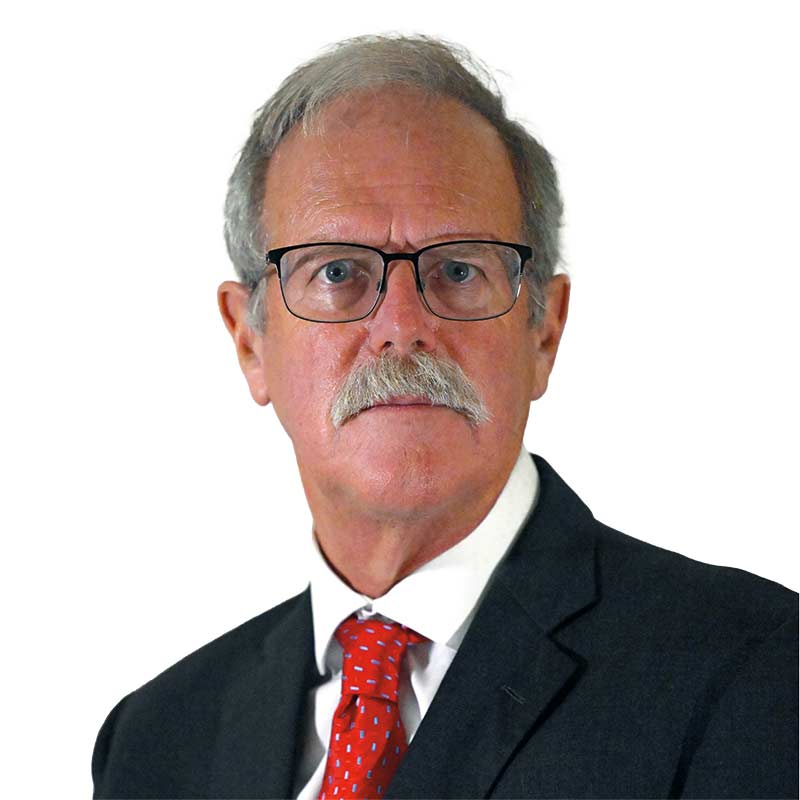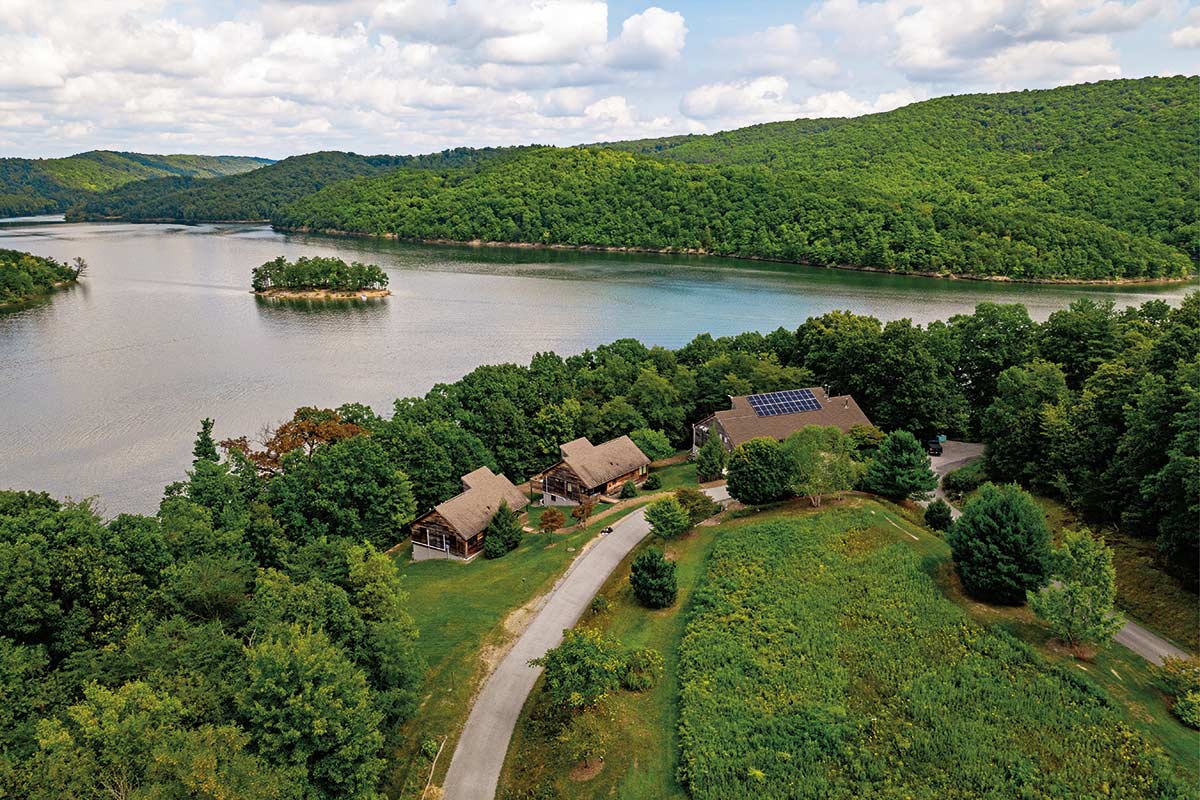by Lawrence Biemiller Photography by Cole Handerhan
ust over half a century ago, as the Army Corps of Engineers was building its new Raystown Dam and acquiring thousands of acres surrounding what would become Raystown Lake, Juniata College Biology Professor Robert Fisher began scouting potential sites for a research facility near the soon-to-be-submerged town of Aitch. In 1972, he settled on a tract of land alongside James Creek where the Grove family had spent decades cutting timber, making maple syrup, and harvesting apples, grapes, and peaches. The property, which the Corps had forced the Groves to sell for $300 per acre, would be at about the halfway point on the new lake.
Students not only study together, in the classroom and in the field, but they also eat weekday meals together ... and in the evenings they may spend time around a campfire beside the lake or by the woodstove in the multipurpose building.
Fisher paid the Groves $1,000 for their house, the heart of which is a historic three-story log building that would otherwise have been demolished, and he arranged to lease 365 acres from the Corps. With help from students, he began building a new road — the old one would soon be beneath the rising waters — and a new connection to the electric grid. The college gave him a quarter-time appointment as director of the new facility, along with a Chevy Suburban and a Boston Whaler.
Bruce Jones '75 was one of the early students to work with Fisher at the new facility, before it had electricity or indoor plumbing. Jones, now a trustee of the college, was also among the first to conduct research on the new lake, well before it opened to the public. When the Boston Whaler arrived with a 55 horsepower Evinrude outboard motor, Jones and another student visited Marty’s Island to document its wildflowers, mice, raccoons, and deer. There were no boat launches yet, Jones remembers (see p. 22). They just backed the boat’s trailer down an existing road until it ran into the water.
Today, of course, Fisher’s facility is one of Juniata’s proudest academic successes, the Raystown Field Station, which celebrates its 50th anniversary this year. Thanks to the addition of a multipurpose building, Shuster Hall, and the Davis and Robison lodges, up to 14 students now spend the entire semester living, learning, and doing research at the field station, which is about a half-hour from the campus. Professors typically drive out to teach day-long classes on Mondays, Tuesdays, Thursdays, and Fridays, with Wednesdays set aside for whatever projects students are working on.

Throughout the fall semester, students at the Raystown Field Station are focused on studying aquatic ecology.
Each semester focuses on one of four topics that are in a regular rotation. This fall is aquatic ecology, next spring will be restoration ecology, fall 2025 will be forest conservation, and spring 2026 will be wildlife conservation. Every semester’s courses mix lectures with outdoor research. For instance, the aquatics curriculum covers limnology — the study of inland aquatic ecosystems — as well as field-research methods and the role of science in society. Each semester also features a week-long trip to study other habitats, such as the coastal shoreline at Virginia’s Chincoteague Island or the forests of the Adirondacks in New York.
“The learning community is the single most powerful tool in undergraduate education,” says Chuck Yohn '83, who retired at the end of last academic year as the field station’s director. “When all your students are taking the same classes, learning success increases a lot.” Students not only study together, in the classroom and in the field, but they also eat weekday meals together — a chef comes out from campus to cook for them during the week — and in the evenings they may spend time around a campfire beside the lake or by the woodstove in the multipurpose building. Students can also commute back to campus for commitments such as student clubs and organizations, on-campus activities, or extracurriculars such as music rehearsals.
The field station welcomes a variety of visitors. It is close enough to Juniata that a professor can easily bring a campus-based class out for an afternoon, and it is also used for faculty and staff retreats, admissions events, high school programs, wilderness first-aid courses, and private parties such as the annual Grove family reunion at the end of every summer. Researchers from other universities regularly stay at the Grove House, and this past summer brought a three-week stay by an artist-in-residence, Kari Roslund, who created collages from local paper artifacts. Twice a year the field station welcomes the public for an apple butter event in the fall and maple syrup making in the spring.
Nesting Turtles and Timber Management
While there are colleges and universities with field stations, many are only used during the summer, rather than during regular semesters. “At a small liberal arts institution, this format is extremely rare,” says Uma Ramakrishnan, who oversees the field station as chair of the environmental science and studies department. The department, she says, is now one of the largest at Juniata. “A large part of our success and growth is tied to the field station, and vice versa.” She notes that many Juniata students get hired for jobs or accepted into graduate programs because of the research they undertake at the field station.
Much of that research is done in cooperation with the U.S. Army Corps of Engineers and with state agencies such as the Pennsylvania Fish and Boat Commission and the Game Commission. Jude Harrington, the Raystown Lake operations manager for the Corps, says Juniata students have been involved with monitoring hydrilla, an invasive aquatic plant; with creating turtle nesting habitats; with studying how the Corps’ timber management practices affect songbird and bat populations; and with research on the hemlock woolly adelgid, a tiny insect from eastern Asia that is threatening hemlock stands throughout eastern North America. Field station students, he notes, “were the first to discover that the striped bass, Raystown Lake’s trophy fish, had low levels of mercury.”

Above: The Grove Farm traces back to 1833, when early settlers to the area first built a cabin, which is still standing to the rear of the existing structure.
The field station, Harrington says, has become “a critical component of the Corps’ environmental stewardship program” at the lake and has offered “multiple benefits” to the agency. Beyond providing research results that have real-world uses, field station students also teach visitors about the environment through the Raystown Conservation Education Partnership, known as RayCEP, in which two Juniata interns spend every summer educating visitors to the lake about various topics. The Corps also regularly hires Juniata students as student rangers.
Abbigail Fields '25 has studied what habitats walleye prefer for spawning and has presented findings at scholarly symposiums and in a paper for the Pennsylvania Fish and Boat Commission. Walleye, she says, like “rock rubble reefs,” which are scarce in a man-made lake like Raystown, so students are testing reefs they’ve created themselves to see how the fish respond. The aim, Fields says, is to help the fish population reproduce naturally so the state can spend less money stocking the lake with fingerlings, which is expensive.
"It’s amazing to be out in the field every day. You all become one big family,” and when there’s free time, “you get to go fishing or hunting or swimming whenever you want."Abbigail Fields ’25
Fields has spent three semesters at the field station and prefers its small scale over living on campus. “It’s amazing to be out in the field every day,” she says. “You all become one big family,” and when there’s free time, “you get to go fishing or hunting or swimming whenever you want.”
Field station semesters also teach professionalism, says Lauren McConahy '24, who spent the spring of her sophomore year there studying restoration ecology. “You have to make sure you’re always prepared when you go out in the field,“ she says. “And you have to be disciplined. You’re learning how to work with 15 people that you’re living with” — a skill she says is particularly important for researchers whose work takes them to remote locations. While she was still an undergraduate. McConahy was hired as a wildlife biology intern for the Pennsylvania Game Commission, and even a brief conversation with her touches on bears, brown bat counts, and lead isotopes in coyote liver samples (possibly from ammunition). She is now enrolled in Juniata’s new master’s program in applied ecology and natural resource management.
“Looking forward, the conversation is about how the field station can expand and capture greater student interest,” says Eric Quallen, the new director. “We want to serve students and offer them an immersive and crucial experience to as many students and as many times as possible.”
When he’s not trying to puzzle it out, Quallen is working to keep on top of everything else — teaching environmental stewardship, coordinating schedules and resources, monitoring budgets, and making sure the two pontoon boats, six canoes, and 17 kayaks are in good order. “You need to be a kind of renaissance person, a jack-of-all-trades,” says Quallen, who came to Juniata after three years at the University of Wyoming’s field station.
"The learning community is the single most powerful tool in undergraduate education. When all your students are taking the same classes, learning success increases a lot."Chuck Yohn ’83
Flexibility is Key
Supporting Quallen — and working daily at the field station — are Chris Bomgardner and Austin Peck '18. As facilities supervisor, Bomgardner provides on-site maintenance expertise and safety instruction. Peck, who lives on site as the program coordinator and serves the students’ residence life adviser, says flexibility is built into everything the field station does. When the Corps of Engineers needs extra hands for their annual hydrilla survey, which involves checking some 500 sites around the lake, classes are canceled for two days. When Game Commission researchers want help trapping and banding wild turkeys for their yearly population survey, students will set up bait stations and then help with the trapping, usually on short notice.
Not even the schedule for making maple syrup is predictable. There are about 450 taps on field station trees, Peck says, but for sugar water to run, the temperature has to be below freezing at night and over 40° Fahrenheit degrees during the day. “You can end up with five gallons of syrup or you can end up with 42,” depending on that year’s weather, he says. In August, this year’s syrup took third place at the Huntingdon County Fair.

Raystown Lake provides a living laboratory for students to learn about lake ecology and monitoring water quality.
Grace Lewis '21 says the field station was what attracted her to Juniata in the first place.Her first field station semester, however, was interrupted when the College went to remote coursework during the early weeks of the COVID pandemic. Faculty members scrambled to reconfigure the semester’s wildlife conservation curriculum, with varying degrees of success. Norris Muth, professor of biology, based his field-research assignments on what students could experience near their homes, which Lewis says worked well, but she missed key wildlife management experiences.
She returned a year later for a restoration ecology semester that she calls redemptive. Meanwhile, she worked with Professor Ramakrishnan on research into the Allegheny woodrat, which lives on slopes of loose rocks called talus. The animals, relatives of packrats, have seen serious population declines because of a raccoon roundworm. Lewis has not only helped study where woodrat populations remain but has used the field station’s lab space to test strategies for protecting them from the worms.
After graduation, Lewis was recruited for a job as a biologist’s aide for the Game Commission. Next she went to work for a conservation center in Alaska, and now she’s working as a forest educator in the Finger Lakes region of New York. As she says, “My experiences at the field station are actively playing out in my everyday life and work.”

Above (L–R): Uma Ramakrishnan, professor and chair of environmental science, natural science division head; Eric Quallen, director of the Raystown Field Station; Austin Peck ’18, program coordinator; Chuck Yohn ’83, retired director of the Raystown Field Station; Lauren Bowen, provost; Chris Bomgardner, facilities supervisor
Centered on Learning
Chuck Yohn ’83 reflects on his leadership of the field station and passes the baton to the next generation.
by Elizabeth HomanChuck Yohn '83 wasn’t serious about Juniata as a college choice until he visited an ecology class taught by the first director of the field station, Bob Fisher. They traveled out to Raystown Lake, and Yohn says he “never got far after that and stayed there for 30 years.”
Yohn worked with Fisher at the field station throughout his four years at Juniata. He graduated and served in the Brethren Volunteer Service and industry. Graduate school at Penn State brought him back to the area and to Fisher’s ecology lab, which he covered when Fisher went out on sabbatical. When Fisher started exploring retirement, Yohn stepped up and eventually grew the field station into what students know today.
Yohn appreciates the field station model that, he says, is “centered on the learning community.” The station operates year round, and students live, work, and learn on site at Raystown Lake and travel across the country to learn at other stations.
Now retired, Yohn knows the field station will always focus on student outcomes. Students “want to make the world a better place,” he says. “Day in and day out, the field station keeps them inspired.”
Eric Quallen, the new director of the field station, knows the field station is Yohn’s legacy and the “result of decades of work and dedication.” Now at the helm, Quallen wants alumni to know that the field station remains a place “where we continue to ask questions, face challenges head on and find solutions, and we will allow our students to be the ones to find those solutions.”

Sugar Time!
by April Feagley g'23When late winter’s frigid overnight temperatures pair with warmer and longer days, the maple trees awaken, and it is sugar weather.
Maple syrup production utilizes spiles (or taps) made from wood, metal, or plastic to harvest the flowing sugar water, which is different from the bitter, sticky sap the tree will produce in hotter months.
A small hole is drilled about two inches deep into the tree, and the narrow end of the spile is tapped into place with a mallet. Most spiles have a hook or ledge to secure a bucket to collect the sugar water.
The sugar bush (a grove of maple trees) at the Raystown Field Station has been tapped for the past 100 years — originally by the Grove family who owned the land until the completion of Raystown Lake. Clair Grove, who had relocated to a farm nearby, returned to the property regularly to teach maple sugaring to Juniata College faculty, staff, and students after the field station was established in 1974.
Every year since, Juniatians of all ages gather at Raystown to enjoy the chill of the late-winter air as they sustain and conserve a century of local tradition. The pilgrimage begins on a day decided by nature — usually in February — when the conditions are determined just right for placing the taps. Over the course of a few weeks, participants collect sugar water, which is then stored in preparation for a much anticipated gathering at the sugar shack. Billowing white clouds of steam rise to the sky above the Grove Farm as excess water is boiled away to create sticky, sweet, and delicious maple syrup that is enjoyed over pancakes and waffles in an informal feast.

From Raystown to Global Impact
Bruce Jones ’75 has led environmental compliance efforts within the energy industry.
by April Feagley g'23
When Bruce Jones '75 first set foot on the grounds of what would eventually become the Raystown Field Station, the site was still untouched by the amenities of modern life.
“I grew up in a suburb where everyone on the street had served in the Army, Navy, or Air Force,” says Jones. “Going to no electricity and outdoor plumbing — it was primitive. But the enthusiasm was there. It was an adventure to get it going, and it enhanced the reason I went on to get a master’s degree in ecology.”
Jones’ journey took him to Rutgers University, where he earned his master’s degree and launched into his career in the environmental and licensing department of a New Jersey electric utility. In a full-circle moment, he found himself overseeing the environmental aspects involved with construction of the Merrill Creek Reservoir in Harmony, N.J. — using the same contractor responsible for the Raystown Dam.
Jones’ career trajectory took a significant turn when he took an environmental position at an Exxon oil refinery, beginning a series of leadership positions within the energy sector, which eventually led to his appointment as executive vice president and CEO at Petroplus, Europe’s largest independent oil refiner by capacity, based in Switzerland.
Now retired, Jones is a member of Juniata’s board of trustees and a generous philanthropic supporter, including giving to the Raystown Field Station, student scholarships, and South Hall, which will be renamed Gibbel Hall in the future, and sponsoring rooms in the newly renovated Statton Learning Commons. As a student, Jones recalls studying with friends in the building when it was known as Beeghley Library.
For current students at the Raystown Field Station, Jones offers this advice: “Take every opportunity you can to maximize your experience while you’re there. You’ve got to be out in the field.”
